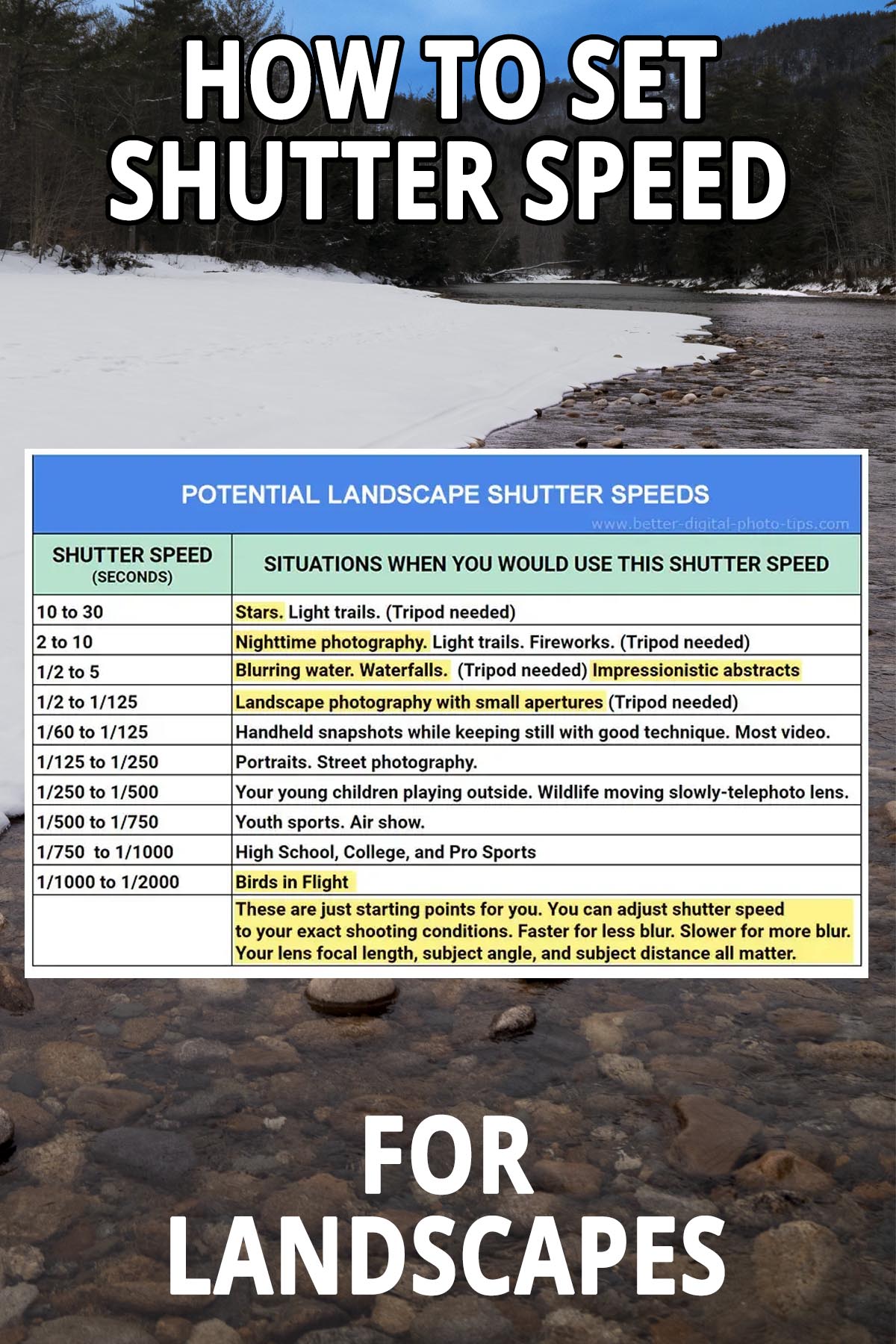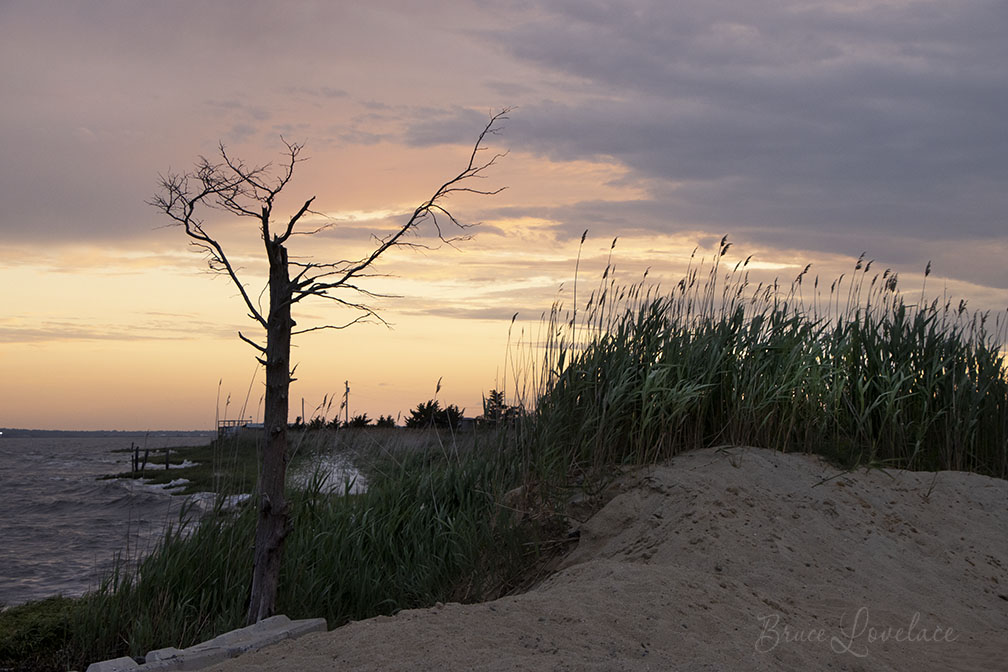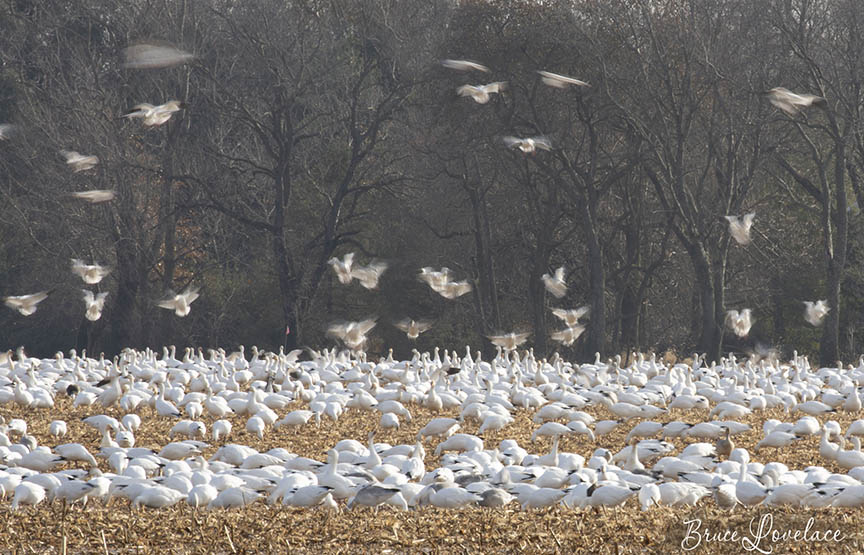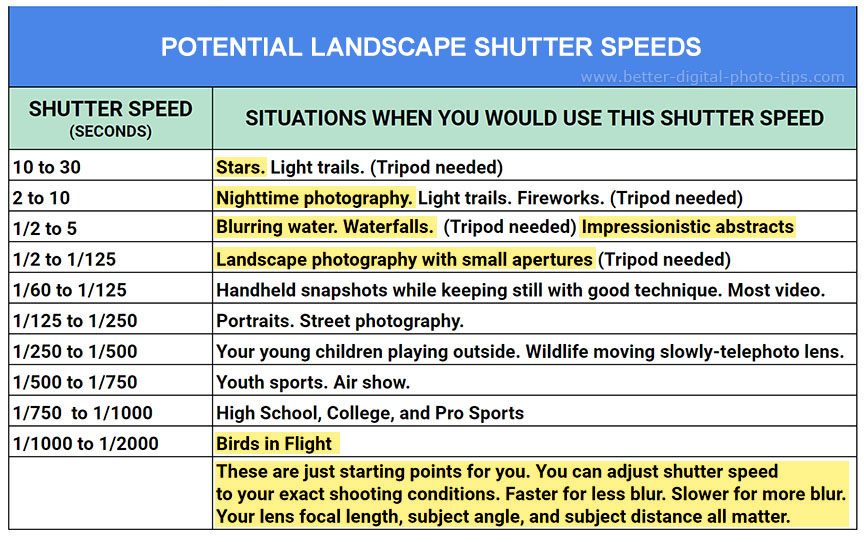HOW TO POSTS: LIGHTING AND COMPOSITION
How to Set Your Shutter Speed For Landscape Photography (3 Simple Steps)
WRITTEN BY: BRUCE LOVELACE
UPDATED: February 4, 2024
Surprisingly, I'm starting this post with an example of using the wrong shutter speed for shooting a landscape photo. Read on to find simple concepts for understanding the recommended shutter speeds in the table above.
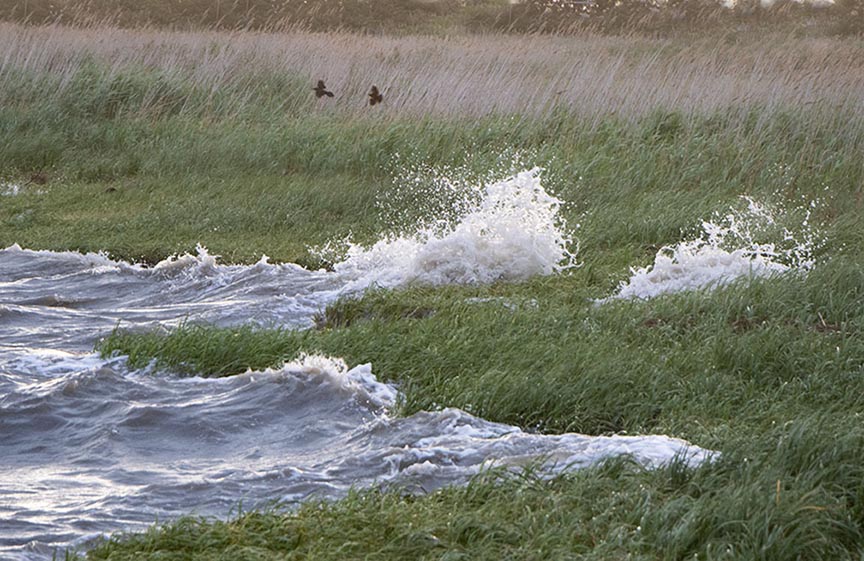 Blurry, even after editing-Not fast enough shutter for these conditions.
Blurry, even after editing-Not fast enough shutter for these conditions.Camera settings were shutter speed @ 1/200 second, aperture @ f/5.6
The importance of selecting the right shutter speed for landscape photography is often forgotten. Landscape photographers traditionally concentrate on 3 things. First, getting the composition just right. Secondly, determining the best aperture to use to control the range of things in focus, the depth of field. Finally, they look for the best light.
Shutter speed is often overlooked. This post will explain why shutter speed is important with landscape photography and how to figure the best shutter speed to use. We'll look at getting the shutter speed right by looking at several sample photos. Then you'll use the 3-step method for determining the best landscape shutter speed.
best shutter speed for landscape photography
There's a quick rule of thumb that says you can take the reciprocal of your lens' focal length and use that as a starting point. With a 50mm lens, you would use a shutter speed of 1/50th second. You can use that in a pinch to get a reasonable sharp photo, but there's so much more to it than that.
The sharpness of your photos depends on how steady your hands are, the camera holding technique you use, as well as the size of your camera sensor.
Landscape photography shutter speeds can range anywhere from several minutes to just a fraction of a second if your scene includes moving objects that you want to have appear sharp in your image.
We start with a few examples of the shutter speeds I used in a several different situations. First we look at the sunrise photo below, a popular subject for a landscape photo. It was taken at 5:33 am when the sun was still below the horizon. Because it was somewhat dark, I had to pay attention to both f/stop and shutter speed numbers.
The light level was low, so I raised the ISO of the camera to 640. That's the threshold I try not to cross. With my particular camera, the noise levels are quite tolerable at ISO 640 for my own personal tastes. With the amount of light that was present at that time, that gave me 1/80 second at f/6.3.
An aperture of f/6.3 produced enough depth of field to keep the sand in the foreground, the dune grass, and the stark silhouette of the tree all in reasonable focus. The shutter speed of 1/80 second was fast enough to keep the dune grass from blurring in the wind.
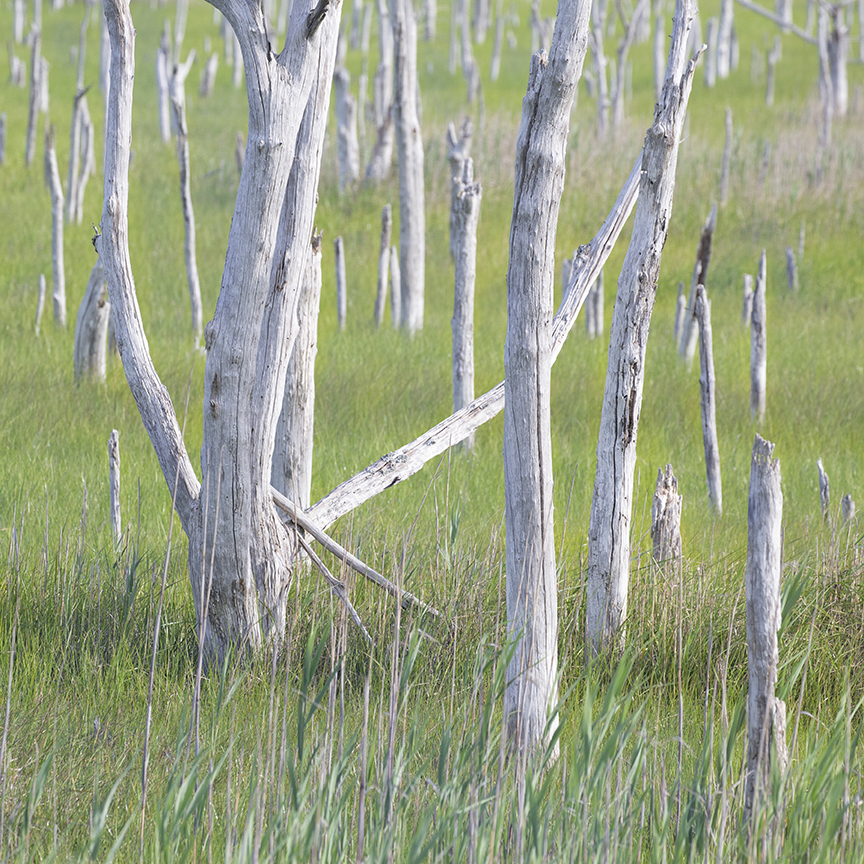 "Cemetery of Trees"
"Cemetery of Trees"Shutter speed of 1/640 second gave me perfect sharpness on my subject with a handheld shot and a long focal length lens.
In the "cemetery of trees" photo above there was very little movement of anything in the scene, but I still needed a fast shutter speed because my tripod was not available and I shot with a big telephoto lens. I chose a very long focal length to "compress" the scene and you need a faster shutter speed to prevent blur from camera movement when using a telephoto.
I usually shoot waterfall landscapes like the one below with a very slow shutter speed.
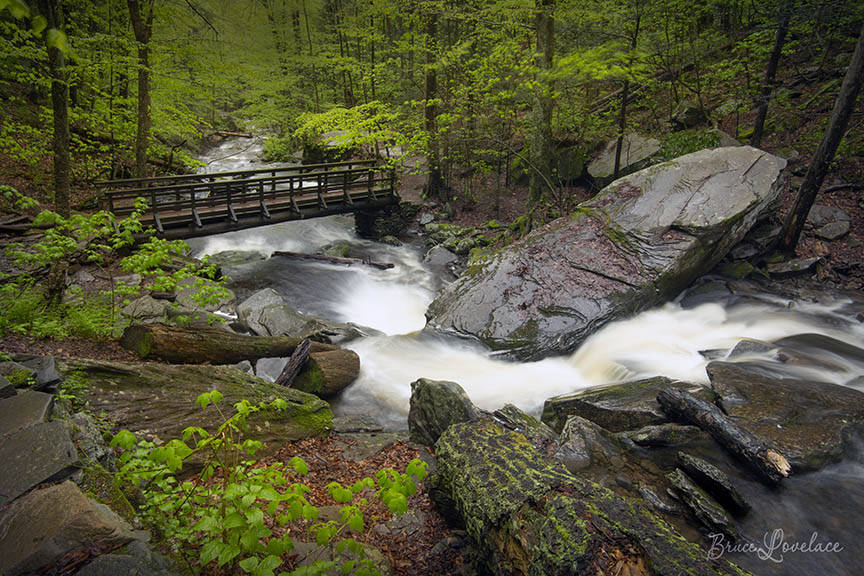 Shutter speed was 1.3 seconds, perfect for a creamy effect in the flowing water.
Shutter speed was 1.3 seconds, perfect for a creamy effect in the flowing water.When shooting waterfall landscapes, you have the option of shooting with slow or fast shutter speeds. Fast shutter speeds will freeze the motion of the water. In the scene above, I chose a slow shutter speed to create the blurring effect in the cascading water. In brightly lit conditions you may have to use a neutral density filter to get a shutter speed slow enough to get the full effect.
The next landscape photo shown below is an interesting mix of static and moving elements. I tried a few different shutter speeds until I got the effect I was after. This image is one of my favorites.
Most of the snow geese were fairly stationary, but several in flight at the same time. The slower shutter speed produced an interesting painterly effect that contrasted nicely against the wooded area on the edge of the field.
how to figure the best shutter speed for landscape photography
Here is the 3-step method you can use to set the shutter speed when shooting landscapes. Step 1 is easy but important to start with. The second step is really what will separate you from other casual landscape snapshot shooters. Looking for what you want to bring out in the vista in front of you, what you want to say about it that interests you.
The third step is all about experimenting with shutter speed and learning from your experiences. The most successful landscape photographers are the ones who have done the most trial runs.
1. Analyze the scene for movement
Look at the scene in front of you. Some landscape scenes have no moving objects within the composition. That could be due a total lack of wind, a lack of vegetation, no moving water, no critters, no leaves on the tree, or a composition with nothing but stationary objects. The scene below was captured on a very calm morning.
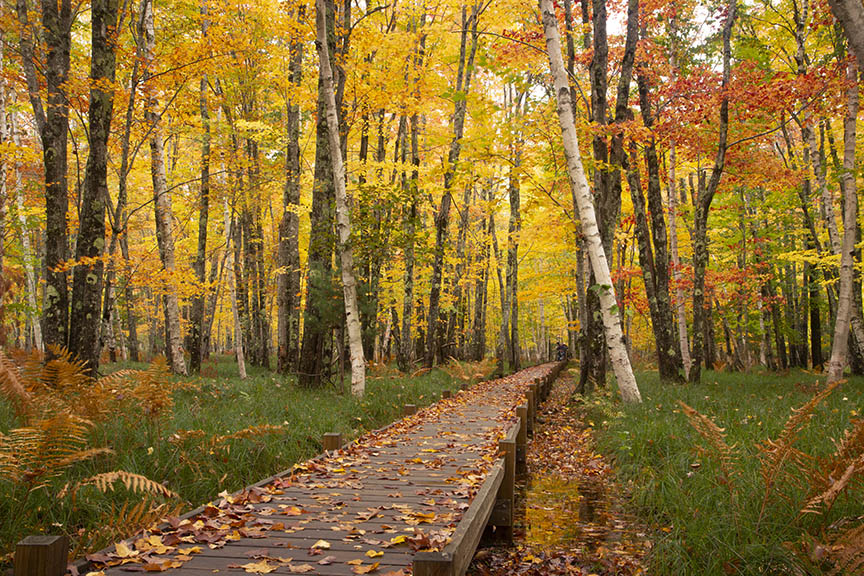 The air was incredibly calm. I used a 0.6 second shutter speed and an aperture of f/14 to keep everything sharp.
The air was incredibly calm. I used a 0.6 second shutter speed and an aperture of f/14 to keep everything sharp.Whatever the reason, it gives you complete flexibility in shooting at practically any shutter speed setting you want. And, of course, you'll be using a tripod. With that freedom, you'll also be able to choose an f/stop that gives you the depth of field you wish to use.
2. determine your desired outcome
Other scenes may have gentle movement caused by the wind where you'll want to use a shutter speed fast enough to freeze the motion. And finally, you may be presented with landscapes that have some rapidly moving parts. You, as the creative artist, can enhance or eliminate the feeling of movement with the shutter speed you choose.
Do you want sharpness throughout your photo, a partial amount of blur, or a significant amount of blur to show the passage of time or create a special effect.
3. estimate the best shutter speed to use
Here's a chart from my detailed post on understanding shutter speeds. It covers a lot more types of photography than landscapes, but it will give you a sense of the variety of shutter speeds you can use for your landscape shots.
when to use slow shutter speeds for landscape photography
DARK CONDITIONS. When there isn't much light available, you may need to keep the shutter open for a longer period of time just to allow enough light to hit the sensor for a good exposure. Opening the lens aperture as wide as possible is another option. Raising your ISO setting is yet one more option. All have their consequences and it will help you to review the exposure triangle and how the 3 factors are interdependent.
CREATIVE MOTION BLUR. It's a lot of fun to experiment with desire motion blur in your landscape photos. Whether it's a waterfall, a river, the ocean, animals on the run, or tall grasses blowing in the wind, the longer shutter speed you use, the more abstract and interesting your photo can become.
LIGHT PAINTING. Light painting is hands down the favorite lesson I teach in my photography workshop for kids. Keeping the shutter open and creating your own lighting with a flashlight, a speedlight, or any other man-made light source gives you limitless possibilities with landscape photos. Here are some fascinating examples.
When to use fast shutter speeds for landscape photography
FREEZE IT. Use a fast shutter speed when you want to avoid any blur from motion. Whether it's leaves dancing from a breeze, water cascading over a rock, or tall dune grass waving in the wind, a fast shutter speed and properly focused lens can give you a razor sharp scenic.
CRITTERS. If your landscape photography includes animals or birds on the move, you can't use those slow shutter speeds if you want those critters to appear sharp in your landscape images.
NO TRIPOD. All serious landscape photographers consider a solid tripod an essential part of their landscape gear. Shooting landscapes without a tripod for me is like showing up to play baseball without a glove. With that said, you may be traveling extra lightly for a variety of reasons. In any case, you'll want to use a fast enough shutter speed to prevent motion from camera movement.
closing remarks on the best shutter speed for shooting landscape photos
Whether you select shutter priority mode and watch what aperture the camera choices, appoint an aperture priority setting and keep an eye on the shutters speed, or you designate both the shutter speed and aperture in manual mode and let the camera select the ISO setting, you need to watch all 3 exposure factors to make sure you get the result you're looking for.
I hope you found this post helpful. For any specific topic on this site use the search box below. For more shutter speed posts use one of the links below my signature.
Search for a new topic on this site:


ABOUT BRUCE LOVELACE
Bruce is the publisher of this website. He is the author of the book "Improve Your Photography Instantly." Read more on Bruce on his Bio Page. He's been known as The Traveling Photographer ever since 1994. Read more about this website.
View some of Bruce's photos on Instagram. Visit the Facebook Page. Watch him on YouTube. Bruce runs photo workshops for kids and adults, and provides one-on-one photography coaching.
Digital Photography Education Location on Google My Business
